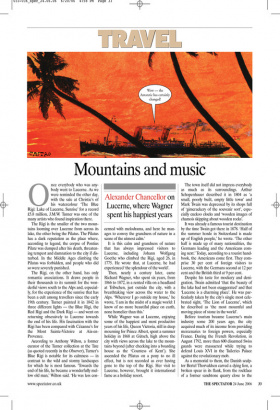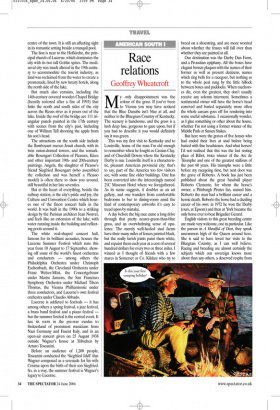Mountains and music
Alexander Chancellor on Lucerne, where Wagner spent his happiest years
Once everybody who was anybody went to Lucerne. As we were reminded the other day, with the sale at Christie’s of his watercolour ‘The Blue Rigi: Lake of Lucerne, Sunrise’ for a record £5.8 million, J.M.W. Turner was one of the many artists who found inspiration there.
The Rigi is the smaller of the two mountains looming over Lucerne from across its lake, the other being the Pilatus. The Pilatus has a dark reputation as the place where, according to legend, the corpse of Pontius Pilate was dumped after his death, threatening tempest and damnation to the city if disturbed. In the Middle Ages climbing the Pilatus was forbidden, and people who did so were severely punished.
The Rigi, on the other hand, has only romantic associations. It draws people in their thousands to its summit for the wonderful views south to the Alps and, especially, for the experience of the sunrise that has been a cult among travellers since the early 19th century. Turner painted it in 1842 in three different lights — the Blue Rigi, the Red Rigi and the Dark Rigi — and went on returning obsessively to Lucerne towards the end of his life. His fascination with the Rigi has been compared with Cézanne’s for the Mont Sainte-Victoire at Aix-enProvence.
According to Anthony Wilton, a former curator of the Turner collection at the Tate (as quoted recently in the Observer), Turner’s Blue Rigi is notable for its calmness — in contrast to the wild and stormy landscapes for which he is most famous. ‘Towards the end of his life, he became a wonderfully mellow old man,’ Wilton said. ‘He was less con cerned with melodrama, and here he manages to convey the grandness of nature in a scene of the utmost calm.’ It is this calm and grandness of nature that has always impressed visitors to Lucerne, including Johann Wolfgang Goethe who climbed the Rigi, aged 26, in 1775. He wrote that, at Lucerne, he had experienced ‘the splendour of the world’.
Then, nearly a century later, came Richard Wagner, who spent six years, from 1866 to 1872, in a rented villa on a headland at Tribschen, just outside the city, with a breathtaking view across the water to the Alps. ‘Wherever I go outside my house,’ he wrote, ‘I am in the midst of a magic world: I know of no more beautiful place on earth, none homelier than this.’ While Wagner was at Lucerne, enjoying some of the happiest and most productive years of his life, Queen Victoria, still in deep mourning for Prince Albert, spent a summer holiday in 1868 at Gütsch, high above the city with views across the lake to the mountains beyond (after checking into a boarding house as the ‘Countess of Kent’). She ascended the Pilatus on a pony to no ill effect, but is not recorded as ever having gone to the top of the Rigi. Her visit to Lucerne, however, brought it international fame as a holiday resort. The town itself did not impress everybody as much as its surroundings. Arthur Schopenhauer described it in 1804 as ‘a small, poorly built, empty little town’ and Mark Twain was depressed by its shops full of ‘gimcrackery of the souvenir sort’, especially cuckoo clocks and ‘wooden images of chamois skipping about wooden rocks’.
It was already a famous tourist destination by the time Twain got there in 1878. ‘Half of the summer horde in Switzerland is made up of English people,’ he wrote. ‘The other half is made up of many nationalities, the Germans leading and the Americans coming next.’ Today, according to a tourist handbook, the Americans come first. They comprise 30 per cent of foreign visitors to Lucerne, with the Germans second at 12 per cent and the British third at 9 per cent.
Despite his taste for mockery and denigration, Twain admitted ‘that the beauty of the lake had not been exaggerated’ and that ‘Lucerne is a charming place’. He was particularly taken by the city’s single most celebrated sight, ‘The Lion of Lucerne’, which he described as ‘the most mournful and moving piece of stone in the world’.
Before tourism became Lucerne’s main industry some 200 years ago, the city acquired much of its income from providing mercenaries to foreign powers, especially France. During the French Revolution, in August 1792, more than 600 disarmed Swiss guards were massacred while trying to defend Louis XVI in the Tuileries Palace against the revolutionary mob.
As a memorial to them, the Danish sculptor Bertel Thorvaldsen carved a dying lion, a broken spear in its flank, from the rockface of a former sandstone quarry close to the centre of the town. It is still an affecting sight in its romantic setting beside a tranquil pool.
The lion is near to the Hofkirche, the principal church of Lucerne, which dominates the city with its two tall Gothic spires. The mediaeval city was much altered in the 19th century to accommodate the tourist industry, as land was reclaimed from the water to create a promenade, lined by new luxury hotels, along the north side of the lake.
But much also remains, including the 14th-century covered wooden Chapel Bridge (heavily restored after a fire of 1993) that links the north and south sides of the city across the Reuss river as it pours out of the lake. Inside the roof of the bridge are 111 triangular panels painted in the 17th century with scenes from the city’s past, including one of William Tell shooting the apple from his son’s head.
The attractions on the south side include the flamboyant rococo Jesuit church, with its twin onion-domed towers, and the remarkable Rosengart Collection of Picassos, Klees and other important 19thand 20th-century paintings. Angela, the daughter of Picasso’s friend Siegfried Rosengart (who assembled the collection and was herself a Picasso model) is often there to show you around, still beautiful in her late seventies.
But at the heart of everything, beside the railway station, is the city’s pride and joy, the Culture and Convention Centre which houses one of the finest concert halls in the world. It was built in the 1990s to a striking design by the Parisian architect Jean Nouvel, and feels like an extension of the lake, with water running inside the building and reflecting pools around it.
The white oval-shaped concert hall, famous for its brilliant acoustics, houses the Lucerne Summer Festival which runs this year from 10 August to 17 September, showing off some of the world’s finest orchestras and conductors — among others the Philadelphia Orchestra under Christoph Eschenbach, the Cleveland Orchestra under Franz Welser-Möst, the Concertgebouw under Mariss Jansons, the San Francisco Symphony Orchestra under Michael Tilson Thomas, the Vienna Philharmonic under three conductors, and Lucerne’s own festival orchestra under Claudio Abbado.
Lucerne is addicted to festivals — it has among others a spring festival, a jazz festival, a brass band festival and a piano festival but the summer festival is the central event. It has its roots in the pre-war exodus to Switzerland of prominent musicians from Nazi Germany and Fascist Italy, and in an open-air concert given on 25 August 1938 outside Wagner’s house at Tribschen by Arturo Toscanini.
Before an audience of 1,200 people, Toscanini conducted the ‘Siegfried Idyll’ that Wagner composed as a serenade for his wife Cosima upon the birth of their son Siegfried. So, in a way, the summer festival is Wagner’s legacy to Lucerne.




















































 Previous page
Previous page